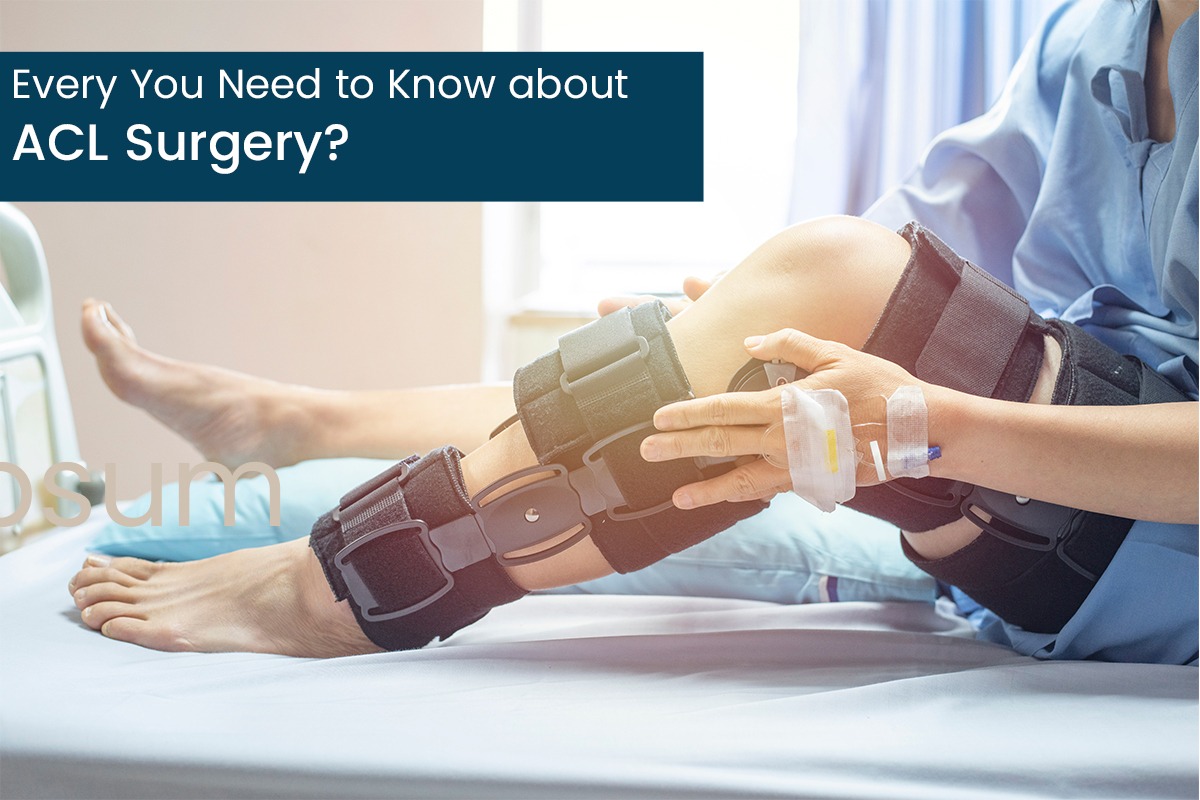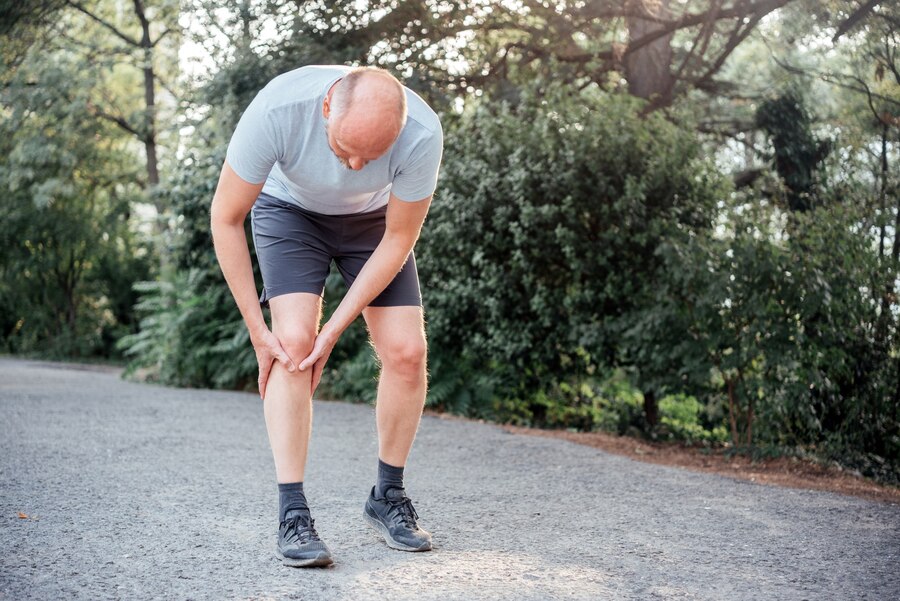Everthing You Need to Know about ACL Surgery?

The ACL, or anterior cruciate ligament, is a crucial ligament in your knee that helps stabilise it during movements like running, jumping, and twisting. When this ligament is injured, it can lead to instability and pain in the knee.
Now you will ask us what is involved in ACL reconstruction, and how is it performed? During ACL surgery, we repair or reconstruct the damaged ligament using either tissue from your own body or a donor graft. This procedure is typically done through small incisions using a tiny camera called an arthroscope, which allows for precision and minimal tissue damage.
After surgery, you’ll undergo a period of rehabilitation to regain strength, flexibility, and stability in your knee. This may involve physical therapy exercises and gradually returning to normal activities.
There are TWO different types of ACL surgery, and the decision on which one is best depends on various factors including the severity of the injury, the patient’s activity level, age, overall health, and personal preferences. The two main types of ACL surgery are…
1. ACL Reconstruction
This involves replacing the torn ACL with a graft, usually taken from the patient’s own tissue (autograft) or a donor tissue (allograft). Common sources for autografts include the patellar tendon, hamstring tendon, or quadriceps tendon. Allografts are typically obtained from cadavers. The choice between autograft and allograft depends on factors such as the patient’s age, activity level, and any previous surgeries.
2. ACL Repair
In some cases, particularly when the ACL tear is partial or located in a specific area of the ligament, it may be possible to repair the ACL rather than reconstruct it. This involves suturing the torn ends of the ligament back together. ACL repair is less common than reconstruction and is typically recommended for specific types of injuries and patients.
The decision on which type of surgery to perform is typically made by the orthopedic surgeon after a thorough evaluation of the patient’s condition, including physical examination, imaging studies (such as MRI), and discussion of the patient’s goals and expectations. The surgeon will consider factors such as the stability of the knee, the presence of associated injuries, and the patient’s lifestyle and activity level.
SOME DEEPER ASPECTS ABOUT THE ACL SURGERY to explain it better why, when would you need it. And also how can you NOT avoid the same, when the doctor asserts for an ACL reconstruction:
1. When ACL Surgery Is Needed and Why can’t it be avoided?
ACL surgery is typically needed when there is a complete tear of the anterior cruciate ligament (ACL) in the knee. This ligament is crucial for stability during activities like running and jumping. Without surgery, the knee may feel unstable, leading to difficulty with daily activities and an increased risk of further injury, such as meniscal tears or cartilage damage. Surgery aims to restore stability to the knee, reduce the risk of future complications, and help patients return to their normal activities.
2. When To See a Specialist, When You get an ACL Tear
If you experience symptoms such as sudden knee pain, swelling, or instability after a twisting or pivoting motion, you should see a specialist, typically an orthopedic surgeon, as soon as possible. They will perform a thorough examination of your knee, possibly including imaging tests like MRI, to diagnose an ACL tear. Early evaluation is crucial to determine the extent of the injury and develop an appropriate treatment plan, which may include ACL reconstruction or conservative management with physical therapy.
3. How are ACL injuries diagnosed?
ACL injuries are diagnosed through a combination of patient history, physical examination, and imaging tests. During the physical examination, the doctor will assess the stability of the knee joint and look for signs of ligament damage, such as swelling, tenderness, and abnormal movement. Imaging tests like MRI (magnetic resonance imaging) provide detailed images of the knee structures, allowing the doctor to visualise the extent of the ACL tear and any associated injuries, such as meniscal tears or bone bruises. This information helps guide treatment decisions, including the need for ACL surgery.
What Are the Treatment Options for an ACL Tear?
Treatment options for an ACL tear typically include surgery and rehabilitation, but the approach depends on various factors such as the severity of the injury, the patient’s activity level, and overall health.
1. Arthroscopic Surgery
This is the most common approach for repairing a torn ACL. It involves making small incisions around the knee and using a tiny camera called an arthroscope to guide miniature surgical instruments. This minimally invasive technique allows for precise repair or reconstruction of the torn ligament. Surgeons usually use a graft, either from the patient’s own tissue (autograft) or a donor (allograft), to replace the torn ACL. Arthroscopic surgery typically results in less pain, faster recovery, and smaller scars compared to open surgery.
2. Open ACL Surgery
In some cases, particularly if there are multiple ligament injuries or complex damage to other knee structures, open surgery may be necessary. This involves making a larger incision to access the knee joint directly. Open surgery may be preferred when additional procedures such as meniscal repair or ligament reconstruction are required. While open surgery may have a longer recovery time and increased risk of complications compared to arthroscopic surgery, it is sometimes necessary for more complex cases.
3. Full Recovery
Regardless of the surgical approach, full recovery from an ACL reconstruction requires comprehensive rehabilitation. Physical therapy plays a crucial role in restoring strength, flexibility, and stability to the knee. Patients typically start with gentle exercises to reduce swelling and improve range of motion, gradually progressing to more challenging activities to rebuild strength and function. Full recovery can take several months, and it’s important for patients to follow their rehabilitation program diligently to achieve the best possible outcomes.
4. Treatment for an ACL Tear
Nonsurgical treatment may include rest, activity modification, bracing, and physical therapy to strengthen the surrounding muscles and improve knee stability. However, nonsurgical treatment may not provide sufficient stability for athletes or individuals with active lifestyles, increasing the risk of recurrent injuries in the long term. Therefore, it’s essential for patients to discuss their options with a healthcare provider to determine the most appropriate treatment plan based on their individual needs and goals.
What is the recovery time for ACL surgery?
Recovery time for ACL surgery varies, but most patients can expect to resume light activities within 1-2 weeks post-surgery. Full recovery typically takes 6-9 months, with patients gradually progressing through physical therapy to rebuild strength, stability, and range of motion in the knee. Return to high-impact sports may take longer, often around 9-12 months, depending on individual factors such as the type of surgery, rehabilitation progress, and adherence to post-operative guidelines.
Exercises after ACL Surgery for Quick Recovery
Here are three types of exercises your doctor or physical therapist may recommend:
1. Range-of-Motion Exercises
Range-of-Motion Exercises with gentle bending and straightening movements, gradually increasing the range of motion over time. Examples include heel slides and knee bends, which you can do while lying down or sitting.
2. Strengthening Exercises
Strengthening Exercises target the muscles around your knee, including the quadriceps, hamstrings, and calf muscles. Start with light resistance and gradually increase as your strength improves. Building strength in these muscles helps support and stabilise your knee joint. Common exercises include leg lifts, hamstring curls, and calf raises.
3. Balance Exercises
Balance Exercises help improve your proprioception, or sense of joint position, which is important for stability and preventing falls. Examples include standing on one leg, using a balance board or stability ball, and performing controlled movements while standing on a stable surface. These exercises challenge your balance and coordination, promoting better control of your knee joint during daily activities and sports.
Summing up…consistency and patience are key to achieving a successful recovery after ACL surgery.
Why Come to Parekhs’ Hospital for ACL Reconstruction?
Parekh’s Hospital in Ahmedabad offers a unique approach to ACL surgery by combining advanced surgical techniques with personalised patient care. We employ a multidisciplinary team of orthopedic surgeons, physical therapists, and sports medicine specialists to provide comprehensive care tailored to each patient’s specific needs and goals.






